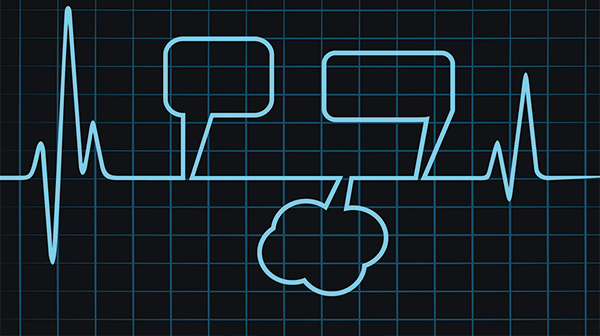
Catch up on some of emergency medicine’s best tweets and learn to pack a punch into 140 characters
Explore This Issue
ACEP Now: Vol 33 – No 02 – February 2014Not addicted to Twitter yet? Not a problem. Here are five recent tweets that’ll give you a sense of what is going on in the emergency medicine Twitterverse.
 1. Graham Walker, MD (@grahamwalker), an emergency physician in San Francisco, asked: “Any pearls/tricks/tips on how people are using their smartphones in the ER?” Dr. Walker is the perfect person to initiate this conversation; his MDCalc website, soon to be an app, is a hugely popular smartphone tool for a variety of clinical uses, providing checklists for clinical decision tools and calculations you can’t quite remember. (Corrected calcium, anyone?) Replies covered a range of tricks that would have made MacGyver proud. Teresa Chan, MD (@TChanMD), an emergency physician with Hamilton Health Sciences in Ontario, replied that she has seen videos of pediatric seizures provided by parents. Seth Trueger, MD (@MDaware), an emergency physician and health-policy fellow at George Washington University in Washington, DC, apparently gets a lot of use out of his smartphone for “Derm tele-consults; [Snellen] eye chart; Patients take pics of their own lesions, ECGs; [I] show parents PECARN algorithm; a metronome for CPR.” Others chimed in, saying they use their phones for keeping important papers handy. Personally, I use checklists and Siri reminders for following up on labs and the camera for taking photographs of medication lists (always with patient permission). And, of course, there is the indispensable flashlight: the ultimate smartphone “PERRL.”
1. Graham Walker, MD (@grahamwalker), an emergency physician in San Francisco, asked: “Any pearls/tricks/tips on how people are using their smartphones in the ER?” Dr. Walker is the perfect person to initiate this conversation; his MDCalc website, soon to be an app, is a hugely popular smartphone tool for a variety of clinical uses, providing checklists for clinical decision tools and calculations you can’t quite remember. (Corrected calcium, anyone?) Replies covered a range of tricks that would have made MacGyver proud. Teresa Chan, MD (@TChanMD), an emergency physician with Hamilton Health Sciences in Ontario, replied that she has seen videos of pediatric seizures provided by parents. Seth Trueger, MD (@MDaware), an emergency physician and health-policy fellow at George Washington University in Washington, DC, apparently gets a lot of use out of his smartphone for “Derm tele-consults; [Snellen] eye chart; Patients take pics of their own lesions, ECGs; [I] show parents PECARN algorithm; a metronome for CPR.” Others chimed in, saying they use their phones for keeping important papers handy. Personally, I use checklists and Siri reminders for following up on labs and the camera for taking photographs of medication lists (always with patient permission). And, of course, there is the indispensable flashlight: the ultimate smartphone “PERRL.”
 2. From Reuben Strayer, MD (@emupdates), assistant clinical professor of emergency medicine at the Icahn School of Medicine at Mount Sinai in New York City: “Use ketamine fearlessly, even recklessly, by understanding the ketamine brain continuum. goo.gl/XGQxTj #emupdates.” This tweet went viral, garnering more than 40 retweets to thousands of people. Dr. Strayer’s postings on his website, EMupdates.com, are always full of supporting resources, including links to high-quality research papers, flow charts, checklists, and screencasts that walk you through everything you need to know. Any fears you may have about ketamine’s safety profile and managing potential emergency reactions from ketamine for procedural sedation are soundly put to rest here, with ample evidence and crystal-clear rationale covering everything from physiology to practice-based guidance. Dr. Strayer’s website may be one of the best-kept secrets in the FOAM (Free Open Access Meducation) world. He doesn’t do a lot of self-promotion, but insiders know he’s a FOAMer’s FOAMite.
2. From Reuben Strayer, MD (@emupdates), assistant clinical professor of emergency medicine at the Icahn School of Medicine at Mount Sinai in New York City: “Use ketamine fearlessly, even recklessly, by understanding the ketamine brain continuum. goo.gl/XGQxTj #emupdates.” This tweet went viral, garnering more than 40 retweets to thousands of people. Dr. Strayer’s postings on his website, EMupdates.com, are always full of supporting resources, including links to high-quality research papers, flow charts, checklists, and screencasts that walk you through everything you need to know. Any fears you may have about ketamine’s safety profile and managing potential emergency reactions from ketamine for procedural sedation are soundly put to rest here, with ample evidence and crystal-clear rationale covering everything from physiology to practice-based guidance. Dr. Strayer’s website may be one of the best-kept secrets in the FOAM (Free Open Access Meducation) world. He doesn’t do a lot of self-promotion, but insiders know he’s a FOAMer’s FOAMite.
Pages: 1 2 3 | Single Page





No Responses to “ED Physicians Tweet About eTools, Ketamine, Evaluating Brain Death, and Free Open Access Meducation (FOAM)”